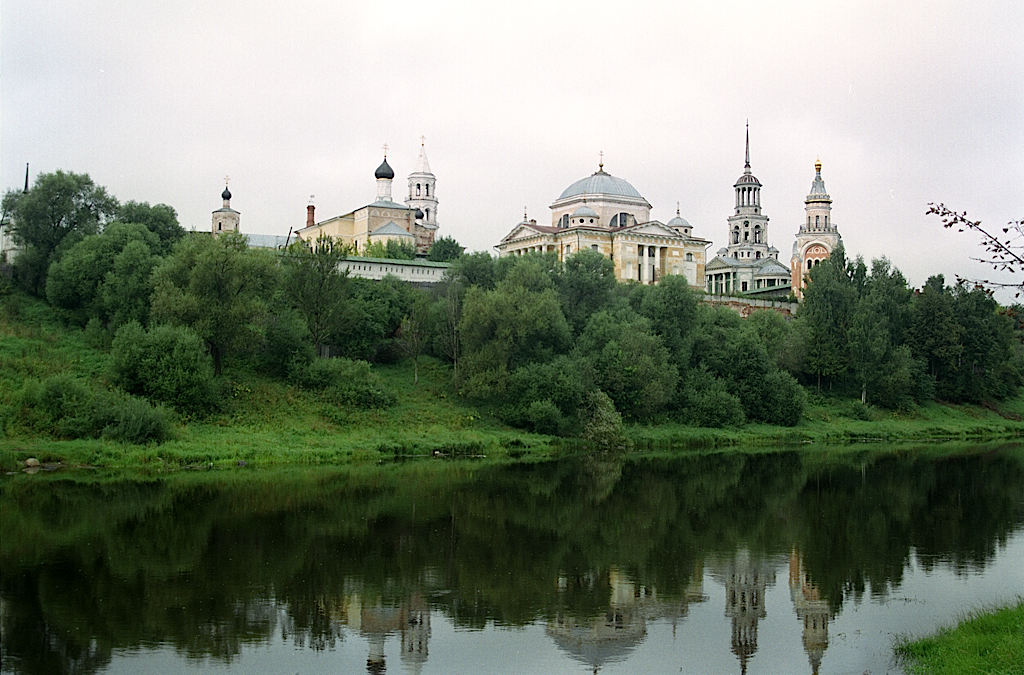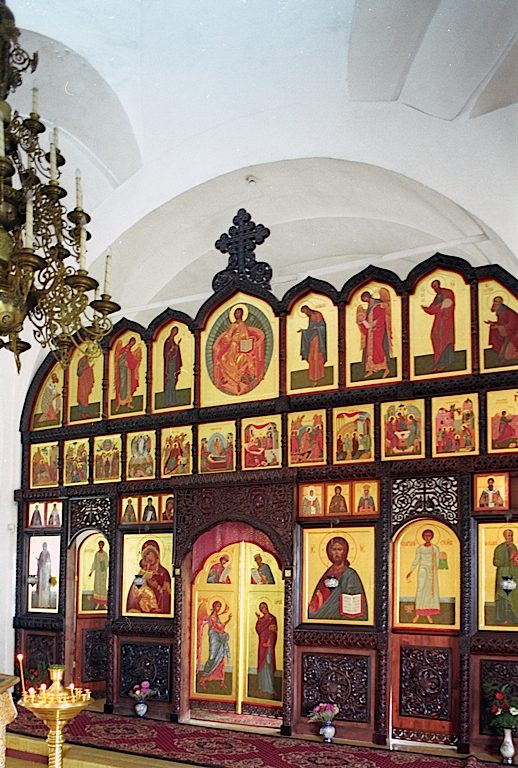Travels Across Russia: Torzhok: Torzhok, Tver, Russia

Panorama with Tvertsa River, north view. Far left: Church of Saint Clement; left: Cathedral of the Transfiguration of the Savior and Novgorod Embankment; center: Tveretskaia Embankment; center background: Church of Elijah the Prophet; right: Resurrection Convent, Church of Saint John the Baptist. Torzhok, Tver, Russia. Copyright: William Craft Brumfield

Boris and Gleb Monastery, southeast view with Tvertsa River. Far left: Church of the Entry into Jerusalem; left: Refectory Church of the Presentation; center: Cathedral of Saints Boris and Gleb; right: Bell Tower and Church of the Miraculous Image of the Savior; far right: Candle (Svechnaia) Tower. Torzhok, Tver, Russia. Copyright: William Craft Brumfield
The dominant feature of historic Torzhok is the Boris and Gleb Monastery, reputed to have been founded in 1083 and dedicated to the earliest martyrs of the Russian Orthodox Church.

Panorama with Candle (Svechnaia) Tower, Boris and Gleb Monastery, northeast view. Torzhok, Tver, Russia. Copyright: William Craft Brumfield

Candle (Svechnaia) Tower, Boris and Gleb Monastery, northwest view. Torzhok, Tver, Russia. Copyright: William Craft Brumfield

Candle (Svechnaia) Tower and Bell Tower, Boris and Gleb Monastery, southeast view. Torzhok, Tver, Russia. Copyright: William Craft Brumfield

The high bell tower of this gate church is Torzhok's most visible landmark.
Bell tower and Church of the Miraculous Icon of the Savior above Holy Gate, Boris and Gleb Monastery, east view. Torzhok, Tver, Russia. Copyright: William Craft Brumfield

In 1785, under Catherine the Great, the old monastery was redesigned by local landowner and architect, Prince Nikolai Lvov. It remains one of the greatest complexes of Russian neoclassicism.
Boris and Gleb Monastery, southeast view. Left: Refectory Church of the Presentation; center: Cathedral of Saints Boris and Gleb. Torzhok, Tver, Russia. Copyright: William Craft Brumfield

Cathedral of Saints Boris and Gleb, Boris and Gleb Monastery, south view. Torzhok, Tver, Russia. Copyright: William Craft Brumfield

Like other provincial towns, Torzhok was essentially rebuilt in the late 18th century, when Catherine the Great decided to transform Russian provincial life by bringing order to town plans. Torzhok benefited from the ideas of classical harmony in the design of a new central square and arcaded market buildings.
Trading Rows, Torgovye Riady Street 2. Torzhok, Tver, Russia. Copyright: William Craft Brumfield

Many of the town's prosperous residents rebuilt their houses in neoclassical designs. A number of these houses still exist, and contribute much to the charm of Torzhok.
Ivan Kutaf'ev House, Red Square 1. Torzhok,Tver, Russia. Copyright: William Craft Brumfield

House, Bakunin Street 9. Torzhok, Tver, Russia. Copyright: William Craft Brumfield

Houses and gates, Mir Street 12 and 14. Torzhok, Tver, Russia. Copyright: William Craft Brumfield

The post road between Moscow and St. Petersburg brought a steady stream of eminent visitors through Torzhok. In the 1770s, Catherine the Great commissioned the architect Matvei Kazakov to build a small "transit palace" for her convenience.
Imperial Transit Palace, southeast view. Torzhok, Tver, Russia. Copyright: William Craft Brumfield

Wooden and log houses from the mid- and late 19th century add to the architectural stylistic mix.
House, Stepan Razin Street 31. Torzhok, Tver, Russia. Copyright: William Craft Brumfield

Log house, Corner of Krasnoarmeiskaia Street and M. Gor'kii Street. Torzhok, Tver, Russia. Copyright: William Craft Brumfield

This 1911 facade displays the late art nouveau style of its era.
House, Tveretskaia Quay 22. Torzhok, Tver, Russia. Copyright: William Craft Brumfield

In 1941, Torzhok was on the front line of the German invasion of Russia. The log Church of the Ascension, built in 1717, astonishingly survived, and its soaring octagonal tower is a remarkable example of wooden church architecture.
Log Church of the Ascension, northwest view. Torzhok, Tver, Russia. Copyright: William Craft Brumfield

Log Church of the Ascension, interior of tower with 19th-century wall paintings. Torzhok, Tver, Russia. Copyright: William Craft Brumfield

The most noticeable evidence of the town's transformation in the late 18th and early 19th centuries is the remarkable number of churches constructed at that time.
Church of Saint John the Baptist, Resurrection Convent, southwest view. Torzhok, Tver, Russia. Copyright: William Craft Brumfield

Torzhok's Cathedral of the Transfiguration of the Savior was founded in 1374. Beginning in 1815, it was rebuilt to a plan by the renowned St. Petersburg architect Carlo Rossi. The current edifice was consecrated in 1822.
Cathedral of the Transfiguration of the Savior, east view across the Tversta River. Torzhok, Tver, Russia. Copyright: William Craft Brumfield

Cathedral of the Transfiguration of the Savior, northeast view. Left background: Church of Entry into Jerusalem. Torzhok, Tver, Russia. Copyright: William Craft Brumfield

Church of Elijah the Prophet, southwest view. Torzhok, Tver, Russia. Copyright: William Craft Brumfield

Church of Saint George, southeast view. Torzhok, Tver, Russia. Copyright: William Craft Brumfield

Another of architect Nikolai Lvov's creations is this well-preserved chapel-rotunda, constructed in 1814.
Chapel of the Holy Cross, Red Square, west view. Torzhok, Tver, Russia. Copyright: William Craft Brumfield

Church of Saint Clement, southeast view. Torzhok, Tver, Russia. Copyright: William Craft Brumfield

Church of Archangel Michael (formerly Church of the Annunciation), south view. Torzhok, Tver, Russia. Copyright: William Craft Brumfield

Church of Saint John the Divine, south view. Torzhok, Tver, Russia. Copyright: William Craft Brumfield

Church of Saint John the Divine, iconostasis, northeast view. Torzhok, Tver, Russia. Copyright: William Craft Brumfield

Znamenskoe-Raek Estate, Church of the Icon of the Sign, south view. Torzhok, Tver, Russia. Copyright: William Craft Brumfield

Just south of Torzhok is the Znamenskoe-Raek Estate. Although some of the park pavilions were damaged or destroyed during the Second World War, the main house and attached buildings are miraculously intact. The estate is undergoing a careful restoration to return it to its former glory.
Znamenskoe-Raek Estate, main house, park facade. Torzhok, Tver, Russia. Copyright: William Craft Brumfield

From 1787 to the 1790s the estate was the scene of intensive construction. Its patron, general and senator Fedor Glebov, wanted to create an idyllic retreat for receiving important guests, and gave the prominent architect Nikolai Lvov full rein for a grand mansion in the Italian style.
Znamenskoe-Raek Estate, main house and cour d'honneur. Torzhok, Tver, Russia. Copyright: William Craft Brumfield

Architect Nikolai Lvov, like the other major Palladian architects in Russia (Giacomo Quarenghi and Charles Cameron), was interested primarily in Palladio's "rural" architecture, and above all his villas. At Raek, the Italian style is particularly evident in the rotunda that rises above the two-story mansion.
Znamenskoe-Raek Estate, main house and cour d'honneur. Torzhok, Tver, Russia. Copyright: William Craft Brumfield

The most distinctive feature of Lvov's design is a grand colonnade that encloses the cour d'honneur in front of the house. It is flanked on either side by pavilions and service buildings that are closely integrated into the colonnade. In the center of the colonnade opposite the mansion is a monumental entrance arch.
Znamenskoe-Raek Estate, cour d'honneur colonnade and pavilions. Torzhok, Tver, Russia. Copyright: William Craft Brumfield

In some respects this extraordinary entrance court is reminiscent of Thomas Jefferson's design for the colonnaded lawn at the University of Virginia. At Znamenskoe-Raek, Lvov created a distinctive approach, not seen elsewhere in Russia, for adapting the natural setting to the neoclassical architectural forms of the manor and its auxiliary buildings.
Znamenskoe-Raek Estate, cour d'honneur colonnade and entrance arch. Torzhok, Tver, Russia. Copyright: William Craft Brumfield

Znamenskoe-Raek Estate, main house interior, main stairway. Torzhok, Tver, Russia. Copyright: William Craft Brumfield

Znamenskoe-Raek Estate, main house interior, vestibule and enfilade. Torzhok, Tver, Russia. Copyright: William Craft Brumfield

The rotunda provides natural light for the ballroom at the center of the second (main) floor. All flanking rooms are subordinate to this square space—a clear indication of the house's reception and entertainment purposes.
Znamenskoe-Raek Estate, main house interior, grand hall with dome. Torzhok, Tver, Russia. Copyright: William Craft Brumfield